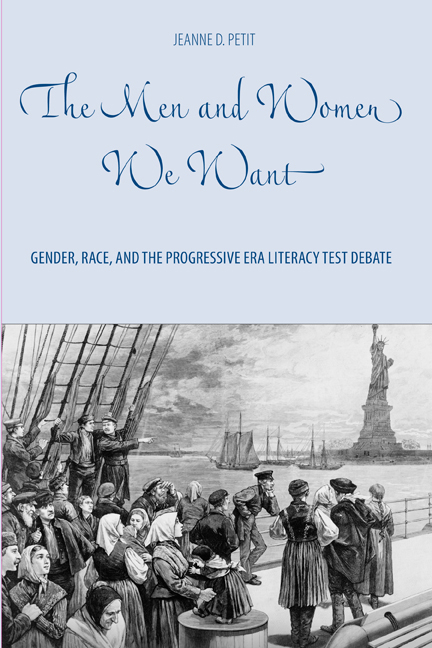Book contents
- Frontmatter
- Dedication
- Contents
- List of Illustrations
- Acknowledgments
- Introduction
- 1 Breeders, Workers, and Mothers: The Beginning of the Literacy Test Debate
- 2 Parents and Progeny: The Dillingham Commission Report
- 3 Muscle, Miscegenation, and Manhood: The Literacy Test at the Height of the Progressive Era
- 4 Practical Aid and Sympathetic Understanding: Grace Abbott's Alternative to the Literacy Test
- 5 World War I and the Literacy Test
- 6 The Legacy of the Progressive Era Literacy Test Debate
- Notes
- Bibliography
- Index
1 - Breeders, Workers, and Mothers: The Beginning of the Literacy Test Debate
Published online by Cambridge University Press: 14 March 2018
- Frontmatter
- Dedication
- Contents
- List of Illustrations
- Acknowledgments
- Introduction
- 1 Breeders, Workers, and Mothers: The Beginning of the Literacy Test Debate
- 2 Parents and Progeny: The Dillingham Commission Report
- 3 Muscle, Miscegenation, and Manhood: The Literacy Test at the Height of the Progressive Era
- 4 Practical Aid and Sympathetic Understanding: Grace Abbott's Alternative to the Literacy Test
- 5 World War I and the Literacy Test
- 6 The Legacy of the Progressive Era Literacy Test Debate
- Notes
- Bibliography
- Index
Summary
The literacy test came into being through the political will of Senator Henry Cabot Lodge and the passion of Prescott Hall and Robert DeCourcy Ward, the young Harvard graduates who founded the Immigration Restriction League (IRL). In the 1880s, these men watched as immigration to the United States nearly doubled from the previous decade and, more worrisome for them, the sources of immigration shifted. The numbers of English, Scandinavians, and other northern Europeans whom they saw as racially compatible stagnated while the numbers of those whom they saw as less racially desirable—Italians, Russians, and other southeastern Europeans—tripled, or even quadrupled. As the IRL's first pamphlet put it, “The quantity of our immigration is increasing … its quality is deteriorating,” and “the results are very dangerous to the country.” By the early 1890s, the men of the IRL and Lodge hit upon a solution: since literacy rates in southeastern European nations were lower, making immigrants pass a literacy test before they could enter the nation would keep out undesirables.
They worked together to write legislation, and in 1896 they saw their chance to get it passed. In the spring of that year, Lodge, the Junior Republican Senator from Massachusetts, introduced a bill calling for Congress to exclude “all persons over 14 years of age who cannot read and write the language of their native country or some other language.” The bill decreed that when immigrants arrived at a port, they would choose the language with which they were most comfortable. The immigration officer would then present the immigrant with a box containing slips of paper with five lines of the United States Constitution written on it. The potential immigrant would draw a slip, read those lines to the inspector, and then copy them down to prove he or she could write. Besides children under fourteen, the only other immigrants exempt from the test would be “aged” parents or grandparents of an admissible or landed immigrant. Lodge hailed this literacy test as a practical method for restriction, as it could fit into the existing inspection system and provide inspectors with a uniform method with which to examine immigrants.
- Type
- Chapter
- Information
- The Men and Women We WantGender, Race, and the Progressive Era Literacy Test Debate, pp. 14 - 30Publisher: Boydell & BrewerPrint publication year: 2010



